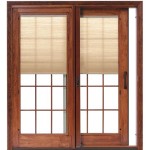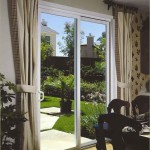Andersen Patio Screen Door Rollers: Understanding Their Function, Maintenance, and Replacement
Andersen patio screen doors are a common feature in many homes, providing ventilation and access to outdoor spaces while keeping insects out. A critical component of these doors is the roller system, which allows for smooth and effortless operation. When these rollers become worn, damaged, or improperly maintained, the door's functionality is significantly compromised. This article provides a comprehensive overview of Andersen patio screen door rollers, covering their function, common issues, maintenance practices, and the process of replacement.
Understanding the Function of Andersen Patio Screen Door Rollers
The primary function of Andersen patio screen door rollers is to facilitate the smooth sliding motion of the screen door along its track. These rollers are typically located at the bottom of the door frame and are designed to bear the weight of the door while minimizing friction. The rollers enable users to easily open and close the screen door, providing convenient access and ventilation. A properly functioning roller system ensures the door glides effortlessly, preventing sticking, binding, or excessive force being required to operate the door.
The design of Andersen patio screen door rollers often incorporates precision bearings to further enhance smooth operation and reduce wear and tear. These bearings are typically sealed to protect them from dirt, debris, and moisture, which can accelerate deterioration and impede performance. The roller material itself is also carefully selected to withstand the constant friction and pressure of daily use. Common materials include nylon, steel, and stainless steel, each offering varying degrees of durability and resistance to corrosion.
The track system that interfaces with the rollers also plays a critical role in the overall performance. A clean and properly aligned track ensures the rollers have a smooth and unobstructed path to follow. Debris accumulation or track damage can significantly impact the roller's ability to function effectively, leading to operational issues.
Common Problems with Andersen Patio Screen Door Rollers
Several factors can contribute to problems with Andersen patio screen door rollers. Over time, the rollers can wear down due to constant use, exposure to the elements, and lack of proper maintenance. The bearings within the rollers can also become compromised, leading to increased friction and reduced smoothness. Some common issues include:
Wear and Tear: This is a natural consequence of prolonged use. The roller surface can become flattened or deformed, reducing its ability to roll smoothly along the track. The bearings can also degrade, causing the roller to bind or seize.
Debris Accumulation: Dust, dirt, leaves, and other debris can accumulate in the track and around the rollers, impeding their movement. This debris can also penetrate the bearings, causing them to become clogged and less efficient.
Corrosion: Exposure to moisture and humidity can cause corrosion, especially in rollers made of less corrosion-resistant materials. This corrosion can lead to rust and pitting, further hindering the rollers' ability to function properly.
Misalignment: Over time, the door frame or track can become misaligned, causing the rollers to experience uneven pressure and wear. This misalignment can also make it difficult to close the door properly, creating gaps that allow insects to enter.
Track Damage: Dents, bends, or other damage to the track can directly impact the rollers' ability to move freely. A damaged track can create uneven surfaces that cause the rollers to jump or skip, making the door difficult to operate.
Identifying the specific cause of the roller problem is crucial for determining the appropriate solution. A visual inspection of the rollers and track can often reveal the source of the issue, allowing for targeted maintenance or replacement.
Maintaining Andersen Patio Screen Door Rollers for Optimal Performance
Regular maintenance is essential for prolonging the life of Andersen patio screen door rollers and ensuring smooth operation. The following maintenance practices are recommended:
Regular Cleaning: The track should be cleaned regularly to remove any accumulated debris. A vacuum cleaner with a brush attachment can be used to remove loose dirt and dust. For stubborn debris, a damp cloth or brush can be used to scrub the track. Ensure the track is completely dry after cleaning to prevent corrosion.
Lubrication: Applying a lubricant to the rollers and track can significantly reduce friction and improve smoothness. A silicone-based lubricant is generally recommended, as it does not attract dirt and debris. Apply the lubricant sparingly to the rollers and track, and wipe away any excess.
Inspection: Periodically inspect the rollers for signs of wear, damage, or corrosion. Check the bearings for smooth operation and listen for any unusual noises when the door is opened and closed. Early detection of problems can prevent more significant issues from developing.
Alignment Adjustment: If the door is difficult to close or appears misaligned, check the alignment of the track and door frame. Minor adjustments can often be made to the door frame or track to improve alignment. Consult the Andersen product manual for specific instructions on alignment adjustments.
By implementing these maintenance practices, homeowners can ensure their Andersen patio screen door rollers remain in good condition and provide smooth, reliable operation for years to come.
Replacing Andersen Patio Screen Door Rollers: A Step-by-Step Guide
When maintenance is no longer sufficient to restore the rollers' performance, replacement becomes necessary. The following steps outline the process of replacing Andersen patio screen door rollers:
Identify the Correct Replacement Rollers: Andersen offers various roller types, so it is crucial to identify the correct replacement rollers for the specific model of screen door. Information about the door model can often be found on a sticker or label located on the door frame. Consult the Andersen website or contact an Andersen dealer to confirm the correct replacement rollers.
Gather Necessary Tools and Materials: The following tools and materials are typically required for replacing Andersen patio screen door rollers: * New replacement rollers * Screwdriver (Phillips or flathead, depending on the roller type) * Putty knife or similar prying tool * Lubricant (silicone-based) * Cleaning supplies (vacuum cleaner, damp cloth)
Remove the Screen Door: Carefully lift the screen door off the track and set it on a flat, protected surface. This will provide access to the rollers for removal and replacement. Depending on the specific door model, the screen door may need to be tilted or angled to disengage it from the track.
Access the Rollers: Locate the rollers at the bottom of the door frame. The rollers are typically held in place by screws or clips. Remove the screws or clips to release the rollers from the door frame.
Remove the Old Rollers: Using a screwdriver or putty knife, carefully pry out the old rollers from the door frame. If the rollers are stuck or difficult to remove, apply a small amount of lubricant to loosen them.
Clean the Roller Cavity: Once the old rollers have been removed, clean the roller cavity to remove any dirt, debris, or corrosion. A small brush or damp cloth can be used for this purpose.
Install the New Rollers: Insert the new rollers into the roller cavity, ensuring they are properly aligned. Secure the rollers in place using the screws or clips that were removed earlier. Ensure the rollers are firmly attached and can rotate freely.
Lubricate the New Rollers: Apply a small amount of silicone-based lubricant to the new rollers to ensure smooth operation. Wipe away any excess lubricant.
Reinstall the Screen Door: Carefully lift the screen door back onto the track, ensuring the rollers are properly positioned. Test the door's operation to ensure it slides smoothly and easily.
Adjust the Rollers (If Necessary): Some Andersen patio screen door rollers are adjustable, allowing for fine-tuning of the door's height and alignment. Consult the Andersen product manual for specific instructions on adjusting the rollers.
By following these steps, homeowners can successfully replace their Andersen patio screen door rollers, restoring the door's smooth and reliable operation.

84 078 Andersen Screen Door Roller Swisco Com

Prime Line White Plastic Sliding Screen Door Roller Andersen Doors B 715 The Home

Andersen 200 Series Perma Shield Gliding Patio Door Rollers

Andersen Original Lower Patio Screen Door Roller Assembly

84 070 Andersen Lower Patio Screen Door Roller Swisco Com

Andersen 200 And 400 Series Gliding Patio Door Insect Screen Replacement Rollers 2 Pack 2500637 The Home

Gliding Patio Door Screen Roller 9130559 Andersen Doors 100 Series Rollers

Andersen Upper Screen Roller Assembly 1991 To Present Windowparts Com

84 020 Screen Door Roller Fits Andersen Swisco Com

Prime Line 2 Pack 1 In Adjustable Plastic Sliding Screen Door Roller Assembly The Assemblies Department At Lowes Com








